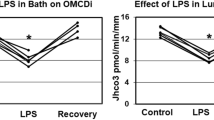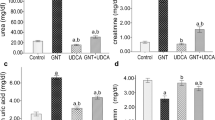Abstract
The cytotoxicity of bacterial cell wall components, muramyl dipeptide (synthetic N-acetylmuramyl-L-alanyl-D-isoglutamine; L,D-MDP) and lipopolysaccharide (LPS), was investigated in several kidney cell lines. MDP and LPS were toxic to rabbit and monkey kidney cells, MDP was toxic to canine kidney cells, but not to human or porcine kidney cells. Notably, L,D-MDP was >100-fold more cytotoxic/μg than the D,D-MDP and L,L-MDP, as well as LPS. L,D-MDP and analogs containing L,D-MDP were the most widely cytotoxic of the MDP tested. The MDP-induced cytotoxicity was characterized as apoptosis by DAPI staining and DNA laddering. The acute rabbit kidney (RK13) cell apoptosis (cell death in <5 h) induced by apical or basal application of MDP was associated with glutamate (Glu) release, decreased γ-glutamyltranspeptidase (GGT) and acidosis and was suppressed by Indomethacin, Naproxen and Curcumin. The cytotoxic activity of L,D-MDP was decreased significantly by 24 h incubation in human sera. Aged (>2 year-old) rabbits that apparently failed to quickly clear and excrete a uveitogenic dose of MDP within 24 h died in 1 week. The results indicate that minute amounts (5 ng/ml) of MDP containing L-alanyl-D-isoglutamine can induce renal cell apoptosis in vitro and support MDP-induced kidney cytotoxicity in rabbits. Also, the results indicate that MDP in sera can be detected utilizing the RK13 cell bioassay and that failure to rapidly clear and excrete L,D-MDP is associated with uveitis and death in aged rabbits.
Similar content being viewed by others
References
Fox A: Role of bacterial debris in inflammatory diseases of the joint and eye. APMIS 98: 857–968, 1990
Zidek Z: Immune-related edemagenic activity of glutamines and glutamic acid, components of immuno-modulatory agents. Agents Actions 42: 163–136, 1994
Riveau G, Masek K, Parant M, Chedid L: Central pyrogenic activity of muramyl dipeptide. J Exp Med 152: 869–877, 1980
Krueger, JM, Pappenheimer JR, Karnovsky ML: Sleep-promoting effects of muramyl peptides. Proc Natl Acad Sci USA 79: 6102–6106, 1982
Biberstine KJ, Rosenthal RS: Peptidoglycan fragments decrease food intake and body weight gain in rats. Infect Immun 62: 3276–3281, 1994
Kotani S, Tsujimoto M, Koga T, Nagao S, Tanaka A, Kawata S: Chemical structure and biological activity relationship of bacterial cell walls and muramyl peptides. Fed Proc 45: 2534–2540, 1986
Sugawara T, Kato M, Furuhama K, Takada S, Takayama S: Pharmacological aspects of arthritis induced by a muramyl dipeptide analogue in rats. Eur J Pharmacol 228: 147–153, 1992
Waters RV, Terrel TG, Jones GH: Uveitis induction in rabbit by muramyl dipeptides. Infect Immun 51: 816–825, 1986
Melly MA, McGee ZA, Rosenthal RS: Ability of monomeric peptidoglycan fragments from Nesseria gonorrhoeae to damage human fallopian-tube mucosa. J Infect Dis 149: 378–386, 1984
Cookson BT, Cho H-L, Herwaldt LA, Goldman W: Biological activities and chemical composition of purified tracheal cytotoxin of Bordetella pertussis. Infect Immun 57: 2223–2229, 1989
Karnovsky ML: Muramyl dipeptides in mammalian tissues and their effects at the cellular level. Fed Proc 45: 2556–2560, 1986
Berg RD: Bacterial translocation from the gastrointestinal tract. Adv Exp Med Biol 473: 11–30, 1999
Johannsen L, Weeke J, Obal F Jr, Krueger JM: Macrophages produce somnogenic and pyrogenic muramyl dipeptides during digestion of Staphyloccocci. Am J Physiol 260: R128–133, 1991
Fox A, Fox K: Rapid elimination of a synthetic adjuvant peptide from the circulation after systemic administration and absence of detectable natural muramyl peptides in normal serum at current analytical limits. Infect Immun 59: 1202–1205, 1991
Kozar MP, Krahmer MT, Fox A, Gray BM: Failure to detect muramic acid in normal rat tissues but detection in cerebrospinal fluids from patients with Pneumococcal meningitis. Infect Immun 68: 4688–4698, 2000
Harrison J, Fox A: Degradation of muramyl dipeptide by mammalian serum. Infect Immun 50: 320–321, 1985
Ladesic B, Tomasic J, Kveder S, Hrsak I: The metabolic fate of 14C-labeled immunoadjuvant peptidoglycn monomer. Biochim Biophys Acta 678: 12–17, 1981
Zikos D, Krueger J, Peterson DR: Renal metabolism of muramyl dipeptide. Contrib Nephrol 68: 19–25, 1988
Wachsmuth ED: Stimulation of cell proliferation in rabbits by MTPPE, a lipophilic muramyl peptide. Virchows Arch B Cell Mol Pathol 54: 195–206, 1988
Seifert J, Sebestova L, Masek K: The stimulatory effect of muramyl dipeptide (MDP) on the proliferation processes in parenchymal organs of rats. Int J Immunopharmacol 10: 67–72, 1988
DeKimpe SJ, Kengatharan M, Thiemermann C, Vane JR: The cell wall components peptidoglycan and lipoteichoic acid from Staphylococcus aureus act in synergy to cause shock and multiple organ failure. Proc Natl Acad Sci USA 92: 10359–10360, 1995
Gstraunthaler G, Holcomb T, Feifel E, Liu W, Spitaler N, Curthoys NP: Differential expression and acid-base regulation of glutaminase mRNAs in gluconeogenic LLC-PK(1)-FBPase(+) cells. Am J Physiol (Renal Physiol) 278: F227–237, 2000
Beale AJ, Christofinis GC, Furminger IGS: Rabbit cells susceptible to rubella virus. Lancet 2: 640–641, 1963
Stanton GJ, Langford MP, Baron S: Effects of interferon, elevated temperature and cell type on replication of acute hemorrhagic conjunctivitis viruses. Infect Immun 18: 370–376, 1977
Langford, MP and Kaiwar, R: An assay for the detection of interferon dependent and interferon independent antibody activities. J Virol Meth 30: 151–160, 1990
Jappesen C, Nielsen PE: Photofootprinting of drug-binding sites on DNA using diazo-and azido-9–aminoacridine derivatives. Eur J Biochem 182: 437–442, 1989
Hogquist KA, Nelt MA, Unanue ER, Chaplin DD: Interleukin which is processed and released during apoptosis. Proc Natl Acad Sci 88: 8485–8490, 1991
Prigent P, Blanpied C, Aten J, Hirsch F: A safe and rapid method for analyzing apoptosis-induced fragmentation of DNA extracted from tissues or cultured cells. J Immunol Meth 160: 139–140, 1993
Langford MP, Chen D, Neff AG, Redens TB, Berg ME, Ganley JP, Dass P, Welbourne TC: Intracameral muramyl dipeptide-induced paracellular permeability associated with decreased glutamate transporter and γ-glutamyltranspeptidase activities. Exp Eye Res 68: 591–600, 1999
Raj D, Langford M, Krueger S, Shelton M, Welbourne T: Regulatory responses to oral D-glutamate load: Formation of Dpyrrolidone carboxylic acid in humans. Am J Physiol 280: E214–E220, 2001
Lipton SA, Rosenberg PA: Excitatory amino acids as a final common pathway for neurologic disease. N Engl J Med 330: 613–622, 1994
Sekura R, van der Waaf P, Meister A: Mechanism and significance of the mammalian pathway for elimination of D-glutamate; inhibition of glutathione by D-glutamate. Biochem Biophys Res Comm 71: 11–18, 1976
Welbourne TC, Chevalier D: Glutamate transport and not cellular content modulates paracellular permeability in LLC-PK+ cells. Am J Physiol 272: 367–370, 1997
McNearney T, Speegle D, Lawand N, Lisse J, Westlund KN: Excitatory amino acid profiles of synovial fluid from patients with arthritis. J. Rheumatol 27: 739–745, 2000
Naskar R, Vorwerk CK, Dreyer EB: Concurrent down-regulation of glutamate transporter and receptor in glaucoma. Invest Ophthalmol Vis Sci 41: 1940–1944, 2000
Chen D, Redens TB, Ganley JP, Texada DE, Langford MP: Apoptosis and γ-glutamyl transpeptidase associated with the disruption of the blood-conjunctival barrier following topical application of muramyl dipeptide. Invest Ophthalmol Vis Sci 42: S256, 2001
Bloksma N, Hofhuis FM, Willers JM: Muramyl dipeptide analogues as potentiators of the antitumor action of endotoxin. Cancer Immunol Immunother 19: 205–210, 1985
Guignot J, Breard J, Bernet-Camrad MF, Peiffer I, Nowicki BJ, Servin AL, Blanc-Potard AB: Pyelonephritogenic diffusely adhering Escherichia coli EC7372 harboring Dr-II adhesin carries classical uropathogenic virulence genes and promotes cell lysis and apoptosis in polarized epithelial caco-2 TC7 cells. Infect Immun 68: 7018–7027, 2000
Parant M, Riveau G, Parant F, Dinarello CA, Wolff SM, Chedid L: Effect of indomethacin on increased resistance to bacterial infection and on febrile responses induced by muramyl dipeptide. J Infect Dis 142: 708–715, 1980
Murdoch WJ, Lund SA: Prostaglandin-independent anovulatory mechanism of indomethacin action: Inhibition of tumor necrosis factor alpha-induced sheep ovarian cell apoptosis. Biol Reprod 61: 1655–1659, 1999
Kettelhut IC, Fiers W, Goldberg AL: The toxic effects of tumor necrosis factor in vivo and their prevention by cyclooxygenase inhibitors. Proc Natl Acad Sci 84: 4273–4277, 1987
Author information
Authors and Affiliations
Rights and permissions
About this article
Cite this article
Langford, M.P., Chen, D., Welbourne, T.C. et al. Stereo-isomer specific induction of renal cell apoptosis by synthetic muramyl dipeptide lpar;N-acetylmuramyl-L-alanyl-D-isoglutamine). Mol Cell Biochem 236, 63–73 (2002). https://doi.org/10.1023/A:1016110429204
Issue Date:
DOI: https://doi.org/10.1023/A:1016110429204




